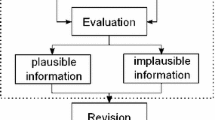Abstract
The notion of epistemic coherence is interpreted as involving not only consistency but also stability. The problem how to consolidate a belief system, i.e., revise it so that it becomes coherent, is studied axiomatically as well as in terms of set-theoretical constructions. Representation theorems are given for subtractive consolidation (where coherence is obtained by deleting beliefs) and additive consolidation (where coherence is obtained by adding beliefs).
Similar content being viewed by others
References
Alchourron, C.E., Gärdenfors, P., and Makinson, D., 1985, “On the logic of theory change: Partial meet contraction and revision functions,” Journal of Symbolic Logic 50, 510–530.
Bonjour, L., 1985, The Structure of Empirical Knowledge, Cambridge, MA and London: Harvard University Press.
Doyle, J., 1992, “Reason maintenance and belief revision: Foundations versus coherence theories,” pp. 29–51 in Belief Revision, P. Gärdenfors, ed., Cambridge, MA: Cambridge University Press.
Galliers, J.R., 1992, “Autonomous belief revision and communication,” pp. 220–246 in Belief Revision, P. Gärdenfors, ed., Cambridge, MA: Cambridge University Press.
Gärdenfors, P., 1988, Knowledge in Flux. Modeling the Dynamics of Epistemic States, Cambridge, MA: The MIT Press.
Gärdenfors, P., 1990, “The dynamics of belief systems: Foundations vs. coherence theories,” Revue International de Philosophie 44, 24–46.
Hansson, S.O., 1994, “Taking belief bases seriously,” pp. 13–28 in Logic and Philosophy of Science in Uppsala, D. Prawitz and D. Westerstähl, eds., Dordrecht: Kluwer Academic Publishes.
Hansson, S.O., 1996a, “Knowledge-level analysis of belief base operations,” Artificial Intelligence 82, 215–235.
Hansson, S.O., 1996b, “Extending Rabinowicz account of stability,” pp. 150–157 in Odds and Ends: Philosophical Essays Dedicated to Wlodek Rabinowicz on the Occasion of His Fiftieth Birthday, S. Lindström, R. Sliwinski, and J. Österberg, eds., Uppsala: Department of Philosophy.
Hansson, S.O. and Olsson, E.J., 1996, “Providing foundations for coherentism,” manuscript.
Harman, G., 1986, Change in View. Principles of Reasoning, Cambridge, MA: The MIT Press.
Klein, P. and Warfield, T.A., 1994, “What price coherence?,” Analysis 54, 129–132.
Lehrer, K., 1990, The Theory of Knowledge, London: Routledge.
Olsson, E.J., “A coherence Interpretation of semirevision,” Theoria, to appear.
Rabinowicz, W., 1989, “Stable and retrievable options,” Philosophy of Science 56, 624–641.
Rabinowicz, W., 1995, “Stable revision, or is preservation worth preserving,” pp. 101–129 in Logic, Action, and Information — Essays on Logic in Philosophy and Artificial Intelligence, A. Fuhrmann and H. Rott, eds., Berlin/New York: Walter de Gruyter.
Rescher, N., 1973, The Coherence Theory of Truth, Oxford: Clarendon Press.
Rescher, N., 1979, Cognitive Systematization, Oxford: Basil Blackwell.
Author information
Authors and Affiliations
Rights and permissions
About this article
Cite this article
Olsson, E.J. Making Beliefs Coherentl. The Subtraction and Addition Strategies.. Journal of Logic, Language and Information 7, 143–163 (1998). https://doi.org/10.1023/A:1008274704871
Issue Date:
DOI: https://doi.org/10.1023/A:1008274704871




